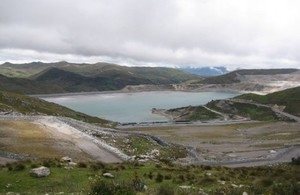Space-based dam monitoring
Reducing the probability of failure of tailings dams through the use of remote sensing data

Tailings dam
Project lead
HR Wallingford
Target country(s)
Peru
Project consortium
Telespazio VEGA, Siemens Corporate Technology, Satellite Application Catapult, Oxford Policy Management, Smith School of Enterprise and the Environment, Oxford University.
International partners
Ciemam, Perú Ministerio de Agricultura y Riego, Autoridad National del Agua (Government of Peru, National Water Authority, Fundación Nacional de Ingeniería Hidráulica (National Foundation for Hydraulics).
Project summary
Tailings dams are earth embankments used to store toxic mine waste and effluent which can be more than 100m high. They are often constructed with steep slopes using the tailings to save on costs. Keeping these structures intact over many decades is challenging. Their rate of failure is high, owing to inadequate design regulations and less rigorous construction methods than for normal water-retaining dams, especially in low-income countries. The rate of tailings dam failures is increasing, with 50% of serious tailings dam failures in the last 70 years occurring between 1990 and 2010. Tailings dams often contain hazardous substances that can contaminate food chains and drinking water.
There is a need for a cost-effective service to both monitor operational and abandoned tailings dams, especially those in remote locations, and to help forecast potentially catastrophic failures. This project will utilise satellite technologies combined with realtime in-situ devices to provide a more cost effective way of remotely measuring displacements of tailing dams and other mining infrastructure. This will reduce the probability of dam failures and pollution incidents. The project involves local stakeholders and representatives of the mining industry in Peru to test this approach on a number of operational and abandoned tailings dams. This project will help to reduce damage to ecosystem services downstream of mines upon which many vulnerable communities rely for both their source of water and their livelihoods.
Objectives
- Develop a robust monitoring system that integrates satellite technologies with real time in-situ devices to provide a cost-effective way of remotely measure monitoring tailings dams and mining facilities.
- Increase the proportion of dams being continuously monitored across the Cajamarca Region by 20%.
- Detect 95% of abnormal normal behaviours of tailings dams in a timely manner.
- Increase, by 20%, the number of mitigation actions taken to correct potential damage and/or failure.
- Reduce the proportion of leakages of toxic chemicals from target tailings dams into local water sources, the environment and associated food chains by 10%.
- Provide a number of recommendations to support the government in taking action to improve regulations for design, construction, maintenance and decommissioning of tailings dams.